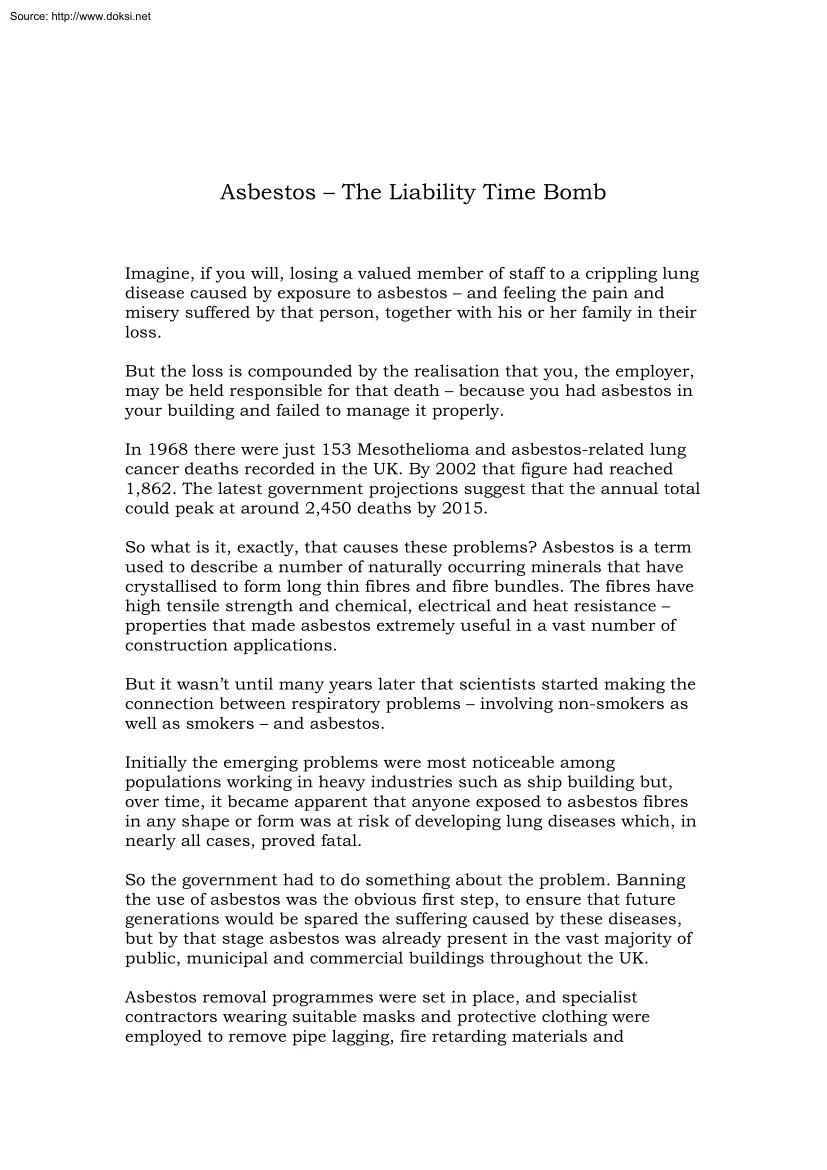A doksi online olvasásához kérlek jelentkezz be!

A doksi online olvasásához kérlek jelentkezz be!
Nincs még értékelés. Legyél Te az első!
Mit olvastak a többiek, ha ezzel végeztek?
Tartalmi kivonat
Source: http://www.doksinet Asbestos – The Liability Time Bomb Imagine, if you will, losing a valued member of staff to a crippling lung disease caused by exposure to asbestos – and feeling the pain and misery suffered by that person, together with his or her family in their loss. But the loss is compounded by the realisation that you, the employer, may be held responsible for that death – because you had asbestos in your building and failed to manage it properly. In 1968 there were just 153 Mesothelioma and asbestos-related lung cancer deaths recorded in the UK. By 2002 that figure had reached 1,862. The latest government projections suggest that the annual total could peak at around 2,450 deaths by 2015. So what is it, exactly, that causes these problems? Asbestos is a term used to describe a number of naturally occurring minerals that have crystallised to form long thin fibres and fibre bundles. The fibres have high tensile strength and chemical, electrical and heat
resistance – properties that made asbestos extremely useful in a vast number of construction applications. But it wasn’t until many years later that scientists started making the connection between respiratory problems – involving non-smokers as well as smokers – and asbestos. Initially the emerging problems were most noticeable among populations working in heavy industries such as ship building but, over time, it became apparent that anyone exposed to asbestos fibres in any shape or form was at risk of developing lung diseases which, in nearly all cases, proved fatal. So the government had to do something about the problem. Banning the use of asbestos was the obvious first step, to ensure that future generations would be spared the suffering caused by these diseases, but by that stage asbestos was already present in the vast majority of public, municipal and commercial buildings throughout the UK. Asbestos removal programmes were set in place, and specialist contractors
wearing suitable masks and protective clothing were employed to remove pipe lagging, fire retarding materials and Source: http://www.doksinet electrical insulation made of asbestos – and to dispose of it properly in specially licensed landfill sites. It soon became clear, however, that this was not enough. Asbestos had been used in products as diverse as tile grout and ceiling paint, meaning that there were still fibres in the air people breathed. The problem was reaching epidemic proportions. On the 21st May 2004 well over 500,000 non-domestic premises in the UK acquired the legal presumption that they contain asbestos, in one form or another. From that date the Control of Asbestos at Work Regulations imposed a new duty on those responsible for the premises to manage the asbestos contained in them. Although asbestos is a hazardous material it can only pose a risk to health if the fibres become airborne and are then inhaled. Therefore, many of the asbestos materials pose little
risk unless they are disturbed in some way that allows the fibres to be released into the atmosphere. Once they get into the lungs, however, these long, thin, sharp fibres can not be removed or even broken down. Over time they become buried within the structure of the lung, but it’s usually quite some time before the effects start manifesting themselves. Mesothelioma is a cancer of the pleural and peritoneal lining considered to be exclusively related to asbestos exposure. By the time it is diagnosed it is almost always fatal. Mesothelioma has a particularly long latency period (the time between initial exposure and onset of the disease) of at least 15 years and sometimes as long as 60 years. Asbestosis is a scarring of the lung tissue. It impairs the elasticity of the lung, hampering its ability to exchange gases. It is a slowly progressive disease with a latency period of between 15 and 30 years. Lung Cancer is a malignant tumour of the bronchi covering. The tumour grows through
surrounding tissue, invading and obstructing air passages. It has a long latency period – typically around 20 years Diffuse Pleural Thickening is a non-malignant disease in which the lining of the lung becomes scarred. It normally takes about 10 years to develop and is a chronic condition for which there is no cure. The injury suffered by those who have contracted these diseases can only be compensated, in Legal terms, by money. Money to replace the income the injured party’s family will need in order to survive, and to try to bring some quality to the remaining, if greatly reduced, life expectancy of sufferers. Source: http://www.doksinet Coroners’ Courts, these days, are quite particular about noting dates and places of employment of the deceased. Those data remain on the record, and you can pretty much guarantee that funeral-chasing lawyers of the future will be trawling their potential. The compensation culture within the UK still has some way to go before it catches up
with that of our American cousins, but it’s getting there. The only defence an employer can have any hope of depending on is that it took every reasonable precaution to protect the health and safety of its employees. Given that the Law is now telling you, in effect, that you have asbestos in your building unless you can prove otherwise, a management plan for dealing with it is the only way you can prove you have taken every reasonable precaution. Without that information, correctly certified, covering every year in which you employ people from now until eternity, your successors may not be able to defend future claims of negligence in the duty of care imposed by the Regulations of the 21st May 2004. If they are left defenceless, they may be able to rely on Employers’ Liability Insurance to bail them out. But don’t bank on it The Insurance industry has suffered growing numbers of asbestosrelated Mesothelioma and Lung Cancer cases in recent years, and is bracing itself against the
possibility of a flood of claims in years to come. Indeed this largely explains the hefty rises in premiums for Public Liability and Employers’ Liability Insurance in the past year or two. And there’s more to come When it comes to submitting the insurance claim, how far do you think Insurers will go to protect an employer who has clearly neglected its duty of care? So where do the funeral-chasing lawyers of tomorrow go next in their quest to have their clients’ claims settled if Insurers won’t pay up? The assets of the employer? Or those of the Directors and Trustees? Or both? Ensuring that your entity is totally compliant with current legislative requirements is, of course, absolutely vital. There are many ways to obtain certification that your premises were free of asbestos on a certain date – a specific snapshot in time – and varying fee levels for the provision of such certificates. But will they be sufficient to prove that you complied with your duty of care throughout
the entire employment period of the deceased? The course taken by government departments in ensuring their own compliance has been to appoint properly qualified, Construction and Source: http://www.doksinet Materials specialist firms to survey their properties with the proverbial toothcomb, and to agree a sensible management plan for the removal or adequate containment of asbestos within their buildings. The costs of removing any asbestos found can be staggeringly high, and a good surveyor will concentrate on how to restrict those costs through containment and management of asbestos within the building, rather than wholesale removal of anything vaguely resembling asbestos. But then a good surveyor will have no vested interest in the profits of the removal companies either. Ends
resistance – properties that made asbestos extremely useful in a vast number of construction applications. But it wasn’t until many years later that scientists started making the connection between respiratory problems – involving non-smokers as well as smokers – and asbestos. Initially the emerging problems were most noticeable among populations working in heavy industries such as ship building but, over time, it became apparent that anyone exposed to asbestos fibres in any shape or form was at risk of developing lung diseases which, in nearly all cases, proved fatal. So the government had to do something about the problem. Banning the use of asbestos was the obvious first step, to ensure that future generations would be spared the suffering caused by these diseases, but by that stage asbestos was already present in the vast majority of public, municipal and commercial buildings throughout the UK. Asbestos removal programmes were set in place, and specialist contractors
wearing suitable masks and protective clothing were employed to remove pipe lagging, fire retarding materials and Source: http://www.doksinet electrical insulation made of asbestos – and to dispose of it properly in specially licensed landfill sites. It soon became clear, however, that this was not enough. Asbestos had been used in products as diverse as tile grout and ceiling paint, meaning that there were still fibres in the air people breathed. The problem was reaching epidemic proportions. On the 21st May 2004 well over 500,000 non-domestic premises in the UK acquired the legal presumption that they contain asbestos, in one form or another. From that date the Control of Asbestos at Work Regulations imposed a new duty on those responsible for the premises to manage the asbestos contained in them. Although asbestos is a hazardous material it can only pose a risk to health if the fibres become airborne and are then inhaled. Therefore, many of the asbestos materials pose little
risk unless they are disturbed in some way that allows the fibres to be released into the atmosphere. Once they get into the lungs, however, these long, thin, sharp fibres can not be removed or even broken down. Over time they become buried within the structure of the lung, but it’s usually quite some time before the effects start manifesting themselves. Mesothelioma is a cancer of the pleural and peritoneal lining considered to be exclusively related to asbestos exposure. By the time it is diagnosed it is almost always fatal. Mesothelioma has a particularly long latency period (the time between initial exposure and onset of the disease) of at least 15 years and sometimes as long as 60 years. Asbestosis is a scarring of the lung tissue. It impairs the elasticity of the lung, hampering its ability to exchange gases. It is a slowly progressive disease with a latency period of between 15 and 30 years. Lung Cancer is a malignant tumour of the bronchi covering. The tumour grows through
surrounding tissue, invading and obstructing air passages. It has a long latency period – typically around 20 years Diffuse Pleural Thickening is a non-malignant disease in which the lining of the lung becomes scarred. It normally takes about 10 years to develop and is a chronic condition for which there is no cure. The injury suffered by those who have contracted these diseases can only be compensated, in Legal terms, by money. Money to replace the income the injured party’s family will need in order to survive, and to try to bring some quality to the remaining, if greatly reduced, life expectancy of sufferers. Source: http://www.doksinet Coroners’ Courts, these days, are quite particular about noting dates and places of employment of the deceased. Those data remain on the record, and you can pretty much guarantee that funeral-chasing lawyers of the future will be trawling their potential. The compensation culture within the UK still has some way to go before it catches up
with that of our American cousins, but it’s getting there. The only defence an employer can have any hope of depending on is that it took every reasonable precaution to protect the health and safety of its employees. Given that the Law is now telling you, in effect, that you have asbestos in your building unless you can prove otherwise, a management plan for dealing with it is the only way you can prove you have taken every reasonable precaution. Without that information, correctly certified, covering every year in which you employ people from now until eternity, your successors may not be able to defend future claims of negligence in the duty of care imposed by the Regulations of the 21st May 2004. If they are left defenceless, they may be able to rely on Employers’ Liability Insurance to bail them out. But don’t bank on it The Insurance industry has suffered growing numbers of asbestosrelated Mesothelioma and Lung Cancer cases in recent years, and is bracing itself against the
possibility of a flood of claims in years to come. Indeed this largely explains the hefty rises in premiums for Public Liability and Employers’ Liability Insurance in the past year or two. And there’s more to come When it comes to submitting the insurance claim, how far do you think Insurers will go to protect an employer who has clearly neglected its duty of care? So where do the funeral-chasing lawyers of tomorrow go next in their quest to have their clients’ claims settled if Insurers won’t pay up? The assets of the employer? Or those of the Directors and Trustees? Or both? Ensuring that your entity is totally compliant with current legislative requirements is, of course, absolutely vital. There are many ways to obtain certification that your premises were free of asbestos on a certain date – a specific snapshot in time – and varying fee levels for the provision of such certificates. But will they be sufficient to prove that you complied with your duty of care throughout
the entire employment period of the deceased? The course taken by government departments in ensuring their own compliance has been to appoint properly qualified, Construction and Source: http://www.doksinet Materials specialist firms to survey their properties with the proverbial toothcomb, and to agree a sensible management plan for the removal or adequate containment of asbestos within their buildings. The costs of removing any asbestos found can be staggeringly high, and a good surveyor will concentrate on how to restrict those costs through containment and management of asbestos within the building, rather than wholesale removal of anything vaguely resembling asbestos. But then a good surveyor will have no vested interest in the profits of the removal companies either. Ends



